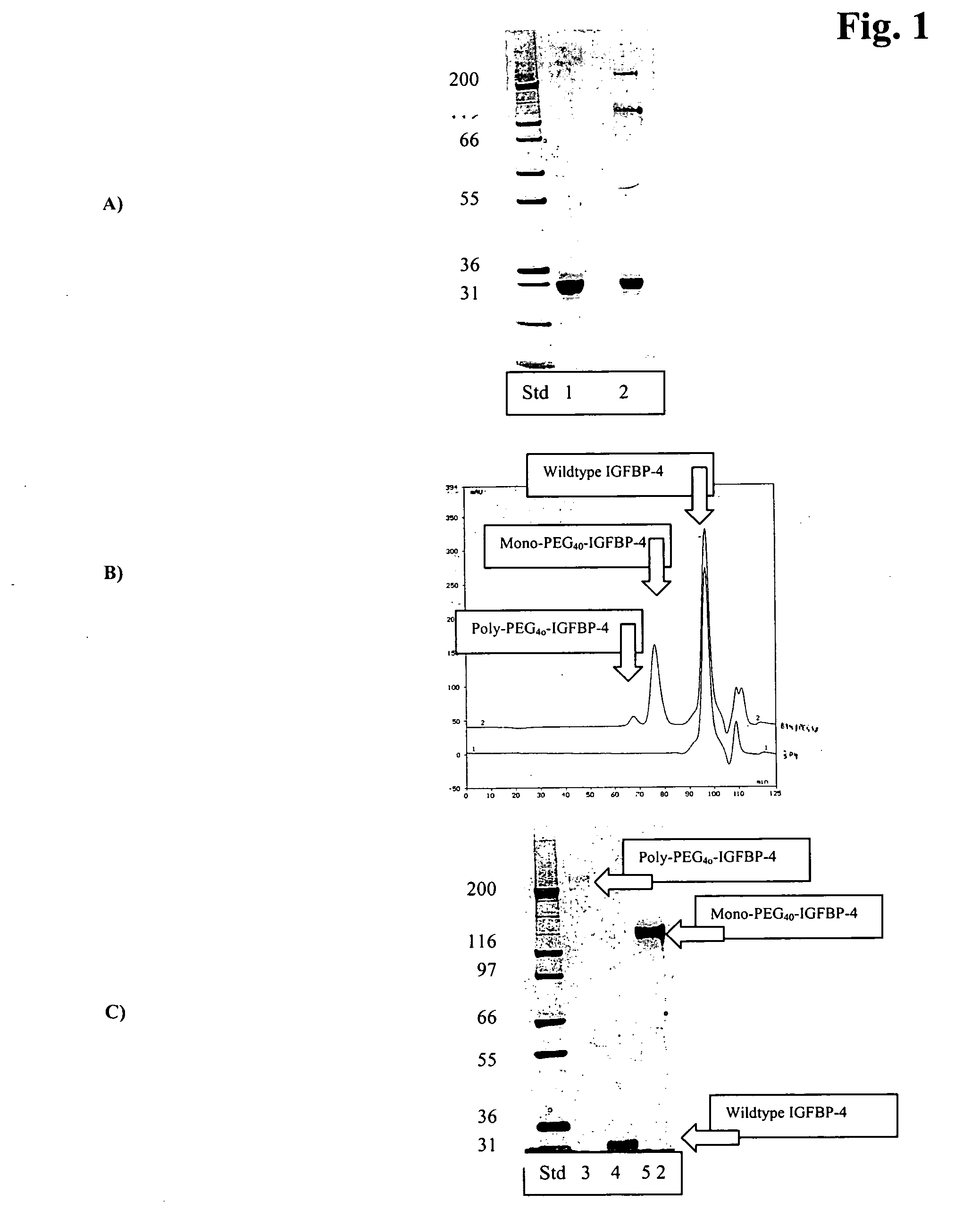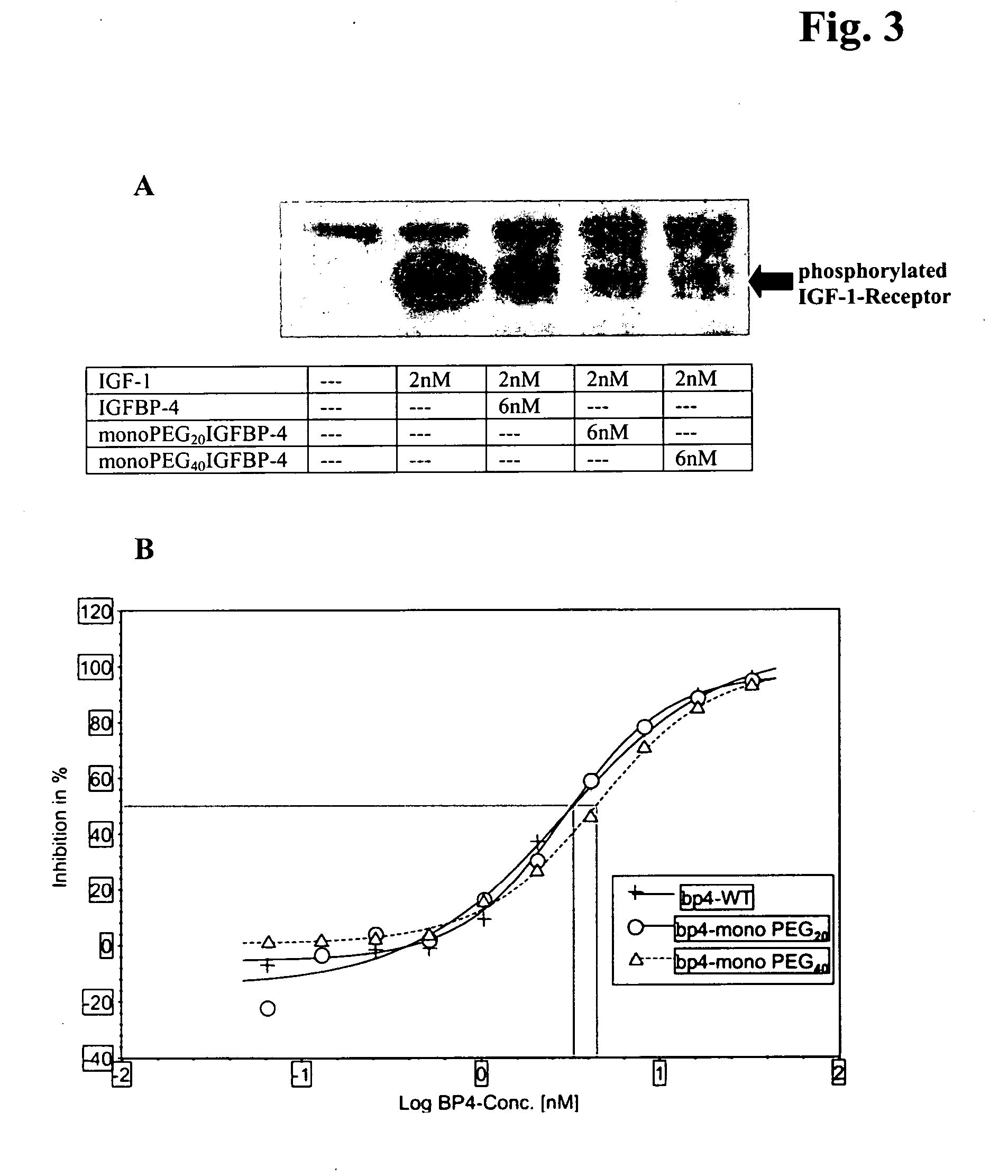Conjugates of insulin-like growth factor binding protein-4 and poly (ethylene glycol)
a technology of growth factor and conjugate, which is applied in the field of conjugates of insulinlike growth factor binding protein4 and poly (ethylene glycol), can solve the problems of significant reduction of igfs binding, loss of biological activity, and many nhs-pegylated proteins that are unsuitable for commercial use, so as to suppress tumor growth, avoid undesired side effects in vivo, and improve tumor treatment
- Summary
- Abstract
- Description
- Claims
- Application Information
AI Technical Summary
Benefits of technology
Problems solved by technology
Method used
Image
Examples
example 1
[0061] Fermentation, Renaturation and Purification of IGFBP-4
[0062] Production of recombinant wildtype IGFBP-4 in E. coli or yeast was described for example by Miyakoshi, N., et al., Endocrinology 142(2001) 2641-2648, and by Kiefer, M. C., et al., J. Biol. Chem. 267 (1992) 12692-12699. Human recombinant IGFBP-4 is further commercially available (e.g. from GroPep Ltd.; Adelaide, Australia).
[0063] Fermentation Conditions:
[0064] Seed culture was performed in a 500 ml Erlenmeyer-flask with a culture volume of 100 ml at 37° C. on a shaking incubator for 7 h. The main culture was carried out in a 10 l fed-batch fermentation with an initial volume of 81. The pH of the culture medium (Springer-Yeast 50 g / l, K2HPO4*3H2O3 g / l, MgSO4*7H2O 0.74 g / l, glucose 4.0 g / l, ampicillin 100 mg / l, kanamycinsulfate 50 mg / l) was maintained at pH 6.8+0.3 by addition of an ammonia solution (12% w / v) as base and a glucosemonohydrate solution (75% w / v) as acid and carbon source. The dissolved oxygen level wa...
example 2
[0073] 40 kDa PEGylation of IGFBP-4 (Random Amino-Reactive PEGylation)
[0074] 40 kDa PEGylation is achieved by reacting IGFBP-4 with mPEG2-NHS ester, a lysine derivative carrying two 20 kDa PEG chains and a single reactive N-Hydroxysuccinimidyl ester (Shearwater Polymers, Inc.; Huntsville, Ala., USA; thereafter named 40 kDa mPEG2).
[0075] IGFBP-4 is PEGylated by the addition of an aqueous solution of 40 kDa mPEG2 to a concentrated IGFBP-4 solution in PBS. 40 kDa mPEG2 was added in a molar ratio of 2 molecules PEG per molecule IGFBP-4. The reaction was allowed to proceed at room temperature for 30 minutes and was finally quenched by adding 1M arginine solution (buffered to pH 8.0 with HCl) to a final concentration of 100 mM.
[0076] The outcome of the PEGylation reaction was optimized for maximal production of monoPEGylated IGFBP-4 with simultaneous minimal consumption of mPEG2-NHS reagent by carefully titrating protein and PEG concentrations. For IGFBP-4, yields of the monoPEGylated ...
example 3
[0077] N-terminal PEGylation of IGFBP-4
[0078] N-terminal specific PEGylation as used herein designates a method of attaching poly(ethylene glycol) chains to a target polypeptide (IGFBP-4) by the use of a poly(ethylene glycol)aldehyde at acidic pH under reducing conditions. The coupling reaction preferentially attaches PEG-aldehyde to the N-terminal aminogroup of a polypeptide chain with little or no side reactions involving ε-amino groups of lysine.
[0079] Human IGFBP-4 was dialyzed against 20 mM acetate buffer, pH4.5 and PEGylated by the addition of an aqueous solution of 40 kDa or 20 kDa PEG-aldehyde (Shearwater Polymers, Inc.; Huntsville, Ala.). PEG-aldehyde was added in a molar ration of 2 molecules PEG per molecule IGFBP-4. PEG-aldehyde forms a Schiff base with the N-terminal amino group which is subsequently (i.e. after one hour of incubation) reduced by the addition of sodium cyano borohydrid to a final concentration of 20 mM. The reaction is allowed to proceed over night at...
PUM
| Property | Measurement | Unit |
|---|---|---|
| Atomic weight | aaaaa | aaaaa |
| Composition | aaaaa | aaaaa |
| Molecular weight | aaaaa | aaaaa |
Abstract
Description
Claims
Application Information
 Login to View More
Login to View More - R&D
- Intellectual Property
- Life Sciences
- Materials
- Tech Scout
- Unparalleled Data Quality
- Higher Quality Content
- 60% Fewer Hallucinations
Browse by: Latest US Patents, China's latest patents, Technical Efficacy Thesaurus, Application Domain, Technology Topic, Popular Technical Reports.
© 2025 PatSnap. All rights reserved.Legal|Privacy policy|Modern Slavery Act Transparency Statement|Sitemap|About US| Contact US: help@patsnap.com



